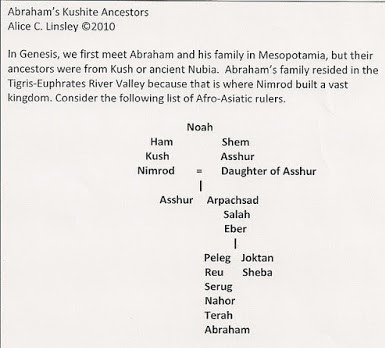Alice C. Linsley
Genesis 10, called a “Table of Nations,” represents an early attempt at ethnography. In his commentary of Genesis, E.A. Speiser described this table “as a pioneering effort among the ethnographic attempts of the ancient world.” (Speiser, The Anchor Bible Commentary on Genesis, p. 71.) The table lists 70 biblical populations with their own lands and nations.
This chapter does not describe nations as we think of them, but rather territories governed by local and regional chiefs who formed alliances for mutual defense. There were a few high kings who ruled larger territories from their royal fortifications. The fortified settlements contained palaces, temples, garrisons, and royal treasuries. These “high places” were the political centers of emerging city-states.
Chapter 10 continues the theme of an eastward movement out of Africa. Adam and Eve went east. Cain went east, and now we read about the dispersion of biblical populations into geographical areas outside of Africa. This is especially evident in the segment about the Kushite kingdom builder Nimrod (Gen. 10: 8-12).
Nimrod is also spelled Nimrudj or Nimrwd. His name, and the name “Lot” are names found among the rulers of the Nile. At least two Nilotic rulers have the name Lot: Takelot I (885–872 BC) and Takelot II (860-835 BC), and at least two Nilotic rulers were called Nimlot. An inscription on the statue of Nimlot B describes him as “Nimlot true of voice,” meaning justified.
In 2010, the 4400-year tomb of a purification priest named Rwd-Ka (Rudj-ka) was found at Giza. It dates to between 2465 and 2323 B.C. His high status is evident in the quality of his stone tomb. He served Pharaoh Khafre who ruled from 2520 to 2494 BC, well before the time of Abraham. The ancient Egyptian word rwd/rudj means ball, sphere, or the Earth. The term “ka” in this context refers to a ruler-priest.
Painting of Rudj-ka and his wife on the wall of his tomb.
This 2800-year fragment was found at the ancient city of Nimrud in modern Iraq. It gives Malku (Melek) as a synonym for Šarru (Sar/Sharru). Both words mean king. (British Museum ND 5434)
Genesis 10 places Nimrod in this area of the Tigris River Valley. It seems that he was a sent-away son of Kush. Likely, his brother Ramah was the proper heir to Kush’s throne.
Genesis 10:7 names Dedan (DD - red one) as a grandson of the Nilotic ruler Kush. Dedan’s father was Ramah, the brother of Nimrod. Abraham was a descendant of Nimrod by his cousin wife, a daughter of Asshur. Here we see further evidence of endogamy between the lines of Ham and Shem. Genesis 11 introduces Abraham’s ancestors descending from Shem.
The various translations of Genesis 10 reveal a discrepancy about a people called Rodanim or Dodanim. Some versions have Rodanim, and others have Dodanim (both plural forms). This discrepancy has been explained by the apparent confusion of the Hebrew letters “resh’ and “dalet” which are similar. The discrepancy also surrounds the place called “Riblah” in some texts and called “Diblah” in others (Ezekiel 6:14).
Here we find evidence for a red population that might be identified with the Horite Hebrew of Edom (Gen. 36). Esau of Edom is described as red, and David, who had Edomite blood, is also described as red or ruddy.
It has been suggested that Rodanim refers to the island of Rhodes (E.A. Speiser), but it is more likely that Genesis 10:4 refers to a population associated with red skin and possibly red hair. The words Dodanim and Dedan refer to the color red. The biradical DD is related to the Ancient Egyptian didi (red fruit) and the Yoruba diden (red).
Related reading: Royal Sons and Their Maternal Uncles; Sent-Away Sons; The Endogamous Lines of Ham and Shem; The Land of Red People; The Social Structure of the Biblical Hebrew; The Marriage and Ascendancy Pattern of Abraham's Hebrew People





.jpg)









No comments:
Post a Comment